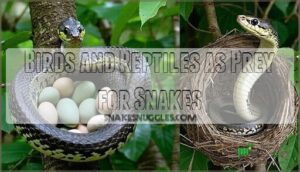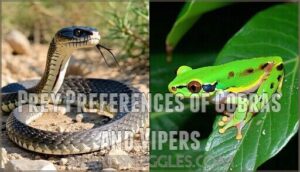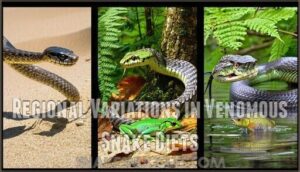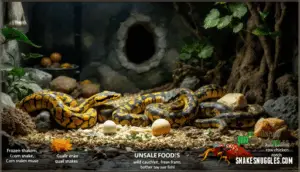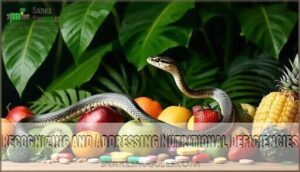This site is supported by our readers. We may earn a commission, at no cost to you, if you purchase through links.

Ball pythons thrive on appropriately-sized rodents every 1-2 weeks, while smaller species like ringneck snakes need frequent meals of insects and worms.
Specialized feeders like egg-eating snakes require completely different approaches altogether.
The snake diet for different species varies dramatically based on size, natural habitat, and hunting behavior.
Getting it right means understanding not just what they’d eat in the wild, but how temperature, humidity, and seasonal cycles affect their appetite and digestion – factors that can make or break your snake’s wellbeing.
Table Of Contents
- Key Takeaways
- Snake Diet and Nutrition Basics
- What Do Different Snake Species Eat
- Dietary Preferences of Venomous Snakes
- Feeding Habits of Non-Venomous Snakes
- Specialized Diets for Specific Snake Species
- Safe and Unsafe Foods for Snakes
- Proper Feeding Techniques and Schedules
- Environmental Factors Affecting Snake Nutrition
- Monitoring and Maintaining Healthy Snake Nutrition
- Recognizing and Addressing Nutritional Deficiencies
- Frequently Asked Questions (FAQs)
- What species of snakes eat other snakes?
- What is the main diet for most snakes?
- What do snakes eat that are not animals?
- What kind of snakes eat frogs?
- Can a snake eat a grasshopper?
- What do non-venomous snakes eat?
- What is a snake’s favorite food?
- Will a snake eat a piece of meat?
- What types of prey do snakes eat?
- What should a pet snake eat?
- Conclusion
Key Takeaways
- Match prey size to your snake’s body width – You’ll need to select rodents, insects, or other prey that matches your snake’s thickest point to prevent regurgitation or injury during feeding.
- Feed according to your snake’s age and species – You should feed hatchlings every 5-7 days, juveniles every 7-10 days, and adults every 10-14 days, but adjust based on whether you’re caring for ball pythons, garter snakes, or other species with different metabolic needs.
- Control temperature and humidity for proper digestion – You must maintain appropriate heat gradients and humidity levels since your snake can’t digest food properly in cold conditions, and low humidity affects shedding and overall health.
- Monitor your snake’s body condition regularly – You’ll catch nutritional problems early by doing weekly weight checks, examining shed quality, and watching for signs like visible spine ridges, lethargy, or poor shedding that indicate malnutrition.
Snake Diet and Nutrition Basics
Understanding your snake’s nutritional needs sets the foundation for their lifelong health and wellness.
You’ll need to balance calcium, phosphorus, vitamin D3, and essential proteins to prevent deficiencies that can lead to serious health problems like metabolic bone disease or poor shedding.
Importance of Calcium and Phosphorus
Balancing calcium and phosphorus forms the cornerstone of your snake’s nutritional health.
Your snake requires a precise 2:1 calcium to phosphorus ratio to prevent metabolic bone disease and support essential bodily functions.
Here’s what proper calcium intake supports in your snake:
- Bone Development – Strong skeletal structure and growth
- Egg Production – Healthy shell formation in breeding females
- Shedding Process – Smooth skin renewal cycles
- Muscle Function – Proper contractions and movement
- Organ Health – Heart and digestive system performance.
Without adequate snake calcium intake, mineral deficiencies develop quickly, compromising your pet’s wellbeing.
Role of Vitamin D3 in Snake Health
Vitamin D3 acts as your snake’s nutritional gatekeeper, enabling proper calcium absorption and preventing metabolic bone disease.
Without adequate D3 from UVB lighting or supplementation, your reptile can’t process calcium effectively, leading to serious health complications.
- Calcium Absorption: D3 transforms calcium into usable form for bone metabolism
- UVB Lighting: Provides natural vitamin D3 synthesis in captive snakes
- D3 Deficiency: Causes soft bones, poor shedding, and reproductive issues
- Supplementation Risks: Over-supplementing can be toxic to your snake
- Metabolic Bone Disease: Prevented through proper D3 and calcium balance
Protein Requirements for Growth and Development
Protein powers your snake’s muscle development through different growth stages.
Hatchling protein needs exceed adult requirements – young snakes need frequent feeding every 5-7 days while adults eat every 10-14 days.
Prey digestion efficiency varies by age, with juveniles processing captive diets faster.
Monitor your snake’s growth to adjust nutritional needs appropriately.
Essential Trace Minerals for Snakes
Mineral powerhouses keep your snake’s body functioning properly, from healthy skin shedding to strong immune responses.
These micronutrients work behind the scenes, supporting everything from blood formation to metabolic processes that keep your reptilian friend thriving.
- Zinc Importance: Essential for proper skin health and successful shedding cycles
- Iron Deficiency: Can lead to anemia and weakened blood oxygen transport
- Selenium Benefits: Boosts immune function and protects against cellular damage
- Copper Needs: Supports metabolism and helps prevent snake nutritional deficiencies
What Do Different Snake Species Eat
Snake species show remarkable dietary diversity based on their size, habitat, and hunting abilities.
You’ll find that while some snakes specialize in specific prey types, others adapt their diet to whatever’s available in their environment, which can be considered as environmental adaptation.
Mammals as Prey for Snakes
Most snakes consider mammals their primary prey, with rodents like mice and rats topping the menu.
Rodent consumption drives many species’ hunting behaviors, while larger constrictors tackle rabbit inclusion in their diets.
Prey size directly affects prey digestion success – size matters when matching meals to your snake’s girth.
Fur impact on digestion remains minimal since snake prey gets swallowed whole, bones and all.
Some animals, like the agile mongoose, are known to hunt snakes.
Birds and Reptiles as Prey for Snakes
When examining avian prey and reptilian diet preferences, you’ll find nest raiding specialists like rat snakes excel at egg consumption from bird nests.
King cobras demonstrate impressive herpetophagy, targeting other snake species regardless of prey size.
Meanwhile, kingsnakes consume both birds and reptiles, including lizards, showcasing remarkable feather digestion capabilities that maximize nutritional benefits.
Studies show that snakes account for a significant percentage of bird nest predation.
Amphibians and Fish as Prey for Snakes
In aquatic environments, numerous snake species have adapted remarkable hunting strategies to capture amphibians and fish as primary food sources. Aquatic Snake Species like garter snakes, water snakes, and anacondas demonstrate impressive Hunting Adaptations that allow them to thrive in semi-aquatic and fully aquatic habitats.
These specialized predators face unique challenges when targeting their slippery prey:
- Amphibian Toxicity poses risks – some frogeating species like kukri snakes have evolved to cut open toads and consume only internal organs, avoiding toxic skin secretions that could prove fatal.
- Fish Nutritional Value varies substantially – while fish provide excellent protein, species high in thiaminase (like goldfish) can cause vitamin B1 deficiencies in captive snakes.
- Spiny fish present choking hazards – some snakes struggle with species having sharp dorsal fins, occasionally resulting in injury or death.
- Habitat Dependence influences prey availability – snake species diets shift seasonally based on amphibian breeding cycles and fish migration patterns.
Understanding these dietary relationships helps you appreciate the complex ecological balance these remarkable predators maintain.
Insects and Other Invertebrates as Prey
Several insectivorous snakes thrive on invertebrate prey, offering excellent nutritional content for smaller species.
These captive diets mirror wild availability patterns, maintaining healthy gut microbiome function.
| Snake Species | Primary Invertebrate Prey | Nutritional Benefits |
|---|---|---|
| Rough Green Snake | Crickets, spiders, caterpillars | High protein, essential amino acids |
| Ringneck Snake | Earthworms, slugs, salamanders | Moisture content, digestible calcium |
| Worm Snake | Ant larvae, termites, beetle grubs | Concentrated nutrients, easy digestion |
| Flowerpot Snake | Small invertebrates, soft-bodied insects | Balanced minerals, natural hydration |
| Smooth Green Snake | Grasshoppers, moths, soft insects | Vitamin-rich, species-appropriate sizing |
Insectivore snakes require specialized feeding approaches.
You’ll find arachnid diet preferences vary markedly between species, making proper invertebrate selection vital for maintaining prime health in your snake diet program.
Dietary Preferences of Venomous Snakes
Venomous snakes have evolved specialized diets that match their deadly hunting abilities, with most species preferring small mammals like rodents and birds.
Deadly precision meets dietary necessity – venomous hunters choose prey that perfectly matches their lethal strike range.
You’ll find that cobras, vipers, and other venomous species use their potent venom not just for defense, but as a precise tool to quickly subdue prey before swallowing it whole.
Prey Preferences of Cobras and Vipers
Cobras and vipers showcase remarkable prey preferences that reflect their venom delivery systems.
These venomous snakes typically target small mammals, birds, and amphibians, with prey size matching their strike range and neurotoxic effects or hemotoxic effects capabilities.
Regional diets vary substantially – Asian cobras prefer rodents while African species hunt birds more frequently.
Prey defenses influence snake hunting behavior, as these predators must balance energy expenditure with successful captures.
- Cobras primarily hunt small mammals like rats and mice
- Vipers target birds, frogs, and small reptiles based on habitat
- Prey size correlates directly with snake’s jaw capacity and venom potency
- Regional diets shift seasonally depending on prey availability
- Snake diet adapts to local prey defenses and hunting opportunities
Hunting Behavior of Venomous Snakes
Now that you’ve seen what cobras and vipers prefer to eat, let’s explore how these venomous hunters actually catch their meals.
Venomous snakes have mastered the art of efficient hunting through specialized techniques that maximize their success while minimizing energy expenditure.
Venom Delivery systems work like precision instruments, with fangs acting as hollow needles that inject toxins directly into prey. Ambush Tactics dominate their hunting repertoire – most venomous species wait motionlessly for hours, relying on camouflage and patience rather than chase scenes.
Here’s what makes their hunting behavior so fascinating:
- Prey Tracking abilities that detect heat signatures and chemical trails
- Strike Precision reaching speeds of 8 feet per second with deadly accuracy
- Venom Effects that immobilize prey within minutes, preventing escape
- Specialized heat-sensing pits that locate warm-blooded targets in darkness
- Lightning-fast reflexes that outmatch even the quickest rodents
This snake diet strategy proves remarkably effective – venomous snakes rarely miss their target once they commit to striking.
Regional Variations in Venomous Snake Diets
Where you find venomous snakes shapes what they eat.
Desert vipers hunt lizards and rodents, while rainforest cobras target amphibians and birds.
Habitat prey availability drives these dietary adaptations, creating regional variations in venomous snake diets.
Seasonal shifts affect prey availability, forcing snakes to adapt their hunting prowess and venom potency accordingly.
Feeding Habits of Non-Venomous Snakes
Non-venomous snakes like boas and pythons rely on constriction rather than venom to secure their meals, making them fascinating hunters with unique feeding strategies.
You’ll discover how these powerful constrictors adapt their diets based on size, habitat, and regional prey availability.
Prey Preferences of Boas and Pythons
Your boa or python’s prey preferences revolve around rodent size that matches their body width.
Wild diets include mammals and birds, while captive diets focus on appropriately sized frozen-thawed prey.
Python diet and boa diet requirements emphasize proper prey size for ideal digestion rates and health.
Hunting Behavior of Non-Venomous Snakes
Through ambush tactics and constrictor methods, you’ll watch nonvenomous snakes master their hunting behavior using sensory cues like heat detection and vibration sensing.
These predators employ diverse prey selection strategies, from juvenile strategies targeting smaller animals to cooperative hunting in some species.
Their snake diet success depends on precise constrictor tactics that efficiently subdue prey without venom assistance.
Regional Variations in Non-Venomous Snake Diets
Why do non-venomous snakes‘ diets vary so dramatically across regions? Local Prey Availability and Habitat Diet Influence shape their feeding patterns substantially.
- Desert species target lizards and small reptiles
- Forest dwellers hunt birds and arboreal prey
- Grassland hunters focus on abundant rodents
- Tropical populations exploit diverse amphibians
Climate Diet Impact and Seasonal Diet Shifts affect hunting prowess and Conservation Diet Needs across different regions. Captive snakes often consume frozen rodents safely.
Specialized Diets for Specific Snake Species
Different snake species have evolved unique dietary requirements that reflect their natural habitats and hunting methods.
You’ll need to understand these specialized feeding needs to provide proper nutrition for your specific snake, whether it’s a massive anaconda requiring large prey or a delicate garter snake thriving on smaller offerings.
Anacondas and Other Large Constrictors
Anacondas pack some serious prey size potential, tackling capybaras and caimans that’d make your pet python jealous.
These constrictors use powerful constriction techniques to subdue massive meals, then coast for weeks between feedings.
Captive feeding requires careful prey size matching and digestive efficiency planning for ideal snake diet success.
Garter Snakes and Other Small Species
When caring for garter snakes and other small species, you’ll discover their diverse appetites make feeding both challenging and rewarding.
These petite predators thrive on varied diets that mirror their natural hunting instincts.
Your small snake’s menu includes:
- Insect Diets – Crickets, grasshoppers, and soft-bodied insects provide essential protein
- Worm Consumption – Earthworms offer balanced nutrition and easy digestion
- Captive Feeding adaptations – Fish like guppies supplement traditional prey safely
Size Matters when selecting appropriate prey – match your snake’s mid-body diameter for ideal digestion.
Garter snakes are also opportunistic carnivorous predators consuming frogs and small rodents.
Ball Pythons and Other Popular Pets
Ball pythons make perfect beginner pets, but they’re notorious picky eaters.
You’ll feed yours appropriately-sized mice or rats every 10-14 days—frozen-thawed prey works best for Captive Diets.
Prey size should match your snake’s thickest body section.
Ball python feeding becomes easier once you understand Morphs Needs don’t change nutritionally.
Enrichment Feeding through varied presentation keeps meals interesting.
Common Issues like food strikes happen, especially during breeding season when Breeding Nutrition shifts focus.
Consistent snake nutrition prevents most snake feeding problems you’ll encounter.
Safe and Unsafe Foods for Snakes
You’ll need to know which foods keep your snake healthy and which ones could harm or even kill them.
Understanding safe versus dangerous food choices helps prevent serious health problems and guarantees your snake thrives on the right diet for its species.
Appropriate Prey Animals for Snakes
When selecting appropriate prey animals for your snake, prey size matters most—it should match your snake’s widest body section.
- Rodents: Mice and rats form the backbone of most snake diets, offering complete nutrition
- Frozen vs. live: Choose frozen-thawed prey to eliminate injury risks and parasites
- Fish and amphibians: Perfect for garter snakes and other aquatic species
- Ethical sourcing: Purchase from reputable suppliers ensuring humane, disease-free prey
Toxic and Harmful Food Items for Snakes
While appropriate prey keeps your snake healthy, certain foods pose serious dangers.
Avocado Toxicity causes heart problems, while wild insects may carry parasites or Chemical Exposure.
Spoiled Prey breeds harmful bacteria, and Toxic Plants like onions trigger severe reactions.
| Food Item | Risk Level |
|---|---|
| Avocado | Fatal toxicity |
| Wild insects | Parasite transmission |
| Spoiled prey | Bacterial infection |
| Toxic plants | Organ damage |
Understanding snake toxicology helps you make informed choices for snake safe feeding practices.
Risks of Feeding Live Prey to Snakes
Feeding live prey often creates unnecessary dangers for your snake.
Live rodents can bite, scratch, or severely injure your pet during feeding encounters.
Key live prey risks include:
- Prey Injury – Rodents fight back with teeth and claws
- Parasite Transmission – Live animals carry diseases and internal parasites
- Stress Factors – Hunting struggles create anxiety for both animals
Humane Alternatives like frozen-thawed prey eliminate these snake safety concerns while maintaining proper snake diet nutrition.
Proper Feeding Techniques and Schedules
Getting the feeding technique right can make the difference between a thriving snake and a stressed one that refuses to eat.
You’ll need to master three key areas: choosing prey that matches your snake’s size, timing meals based on age and species, and presenting food safely to avoid injury.
Determining Appropriate Prey Size for Snakes
Understanding prey size can make or break your snake’s health. You wouldn’t stuff a tennis ball down a garden hose, right? The same logic applies here.
Prey Girth should match your snake’s thickest point. Species Variation matters—ball pythons handle different sizes than corn snakes. Snake Age affects capacity too.
Knowing the appropriate prey options can help guarantee a balanced diet.
| Snake Size | Appropriate Prey |
|---|---|
| Juvenile | Mouse pinkies/fuzzies |
| Adult | Adult mice/small rats |
| Large species | Rats/rabbits |
Feeding Safety depends on proper sizing. Too large risks regurgitation or injury. Digestion Rate slows with oversized meals.
Snake nutrition suffers when snake feeding goes wrong. Follow snake prey size guidelines for ideal snake diet success.
Feeding Frequency Based on Age and Species
Your snake’s age determines its dinner schedule. Hatchling frequency means meals every 5-7 days for rapid growth.
Juvenile schedules stretch to 7-10 days as metabolism slows. Adult intervals become 10-14 days with slower needs.
Species variations matter too – ball pythons may fast seasonally while garter snakes eat regularly year-round.
- Tiny appetites: Hatchlings eat like teenagers at a pizza party
- Growing pains: Juveniles balance growth spurts with developing patience
- Mature wisdom: Adults master the art of scheduled satisfaction
- Natural rhythms: Some species dance to seasonal feeding cycles
Handling and Presentation of Food to Snakes
Once you’ve nailed your feeding frequency, proper handling keeps everyone safe.
Feeding tools like tongs prevent accidental bites, while prey thawing guarantees proper temperature. Scenting prey helps picky eaters, and frozen-thawed prey reduces live feeding risks.
Match prey size to your snake’s girth for easy swallowing.
Many keepers acquire specialized feeding equipment for their snakes.
| Feeding Tools | Purpose |
|---|---|
| Feeding tongs | Prevent accidental bites |
| Heat source | Proper prey thawing |
| Scenting materials | Encourage feeding response |
| Clean workspace | Reducing stress during meals |
Environmental Factors Affecting Snake Nutrition
Your snake’s environment directly controls how well it digests food and absorbs nutrients. Temperature, humidity, and lighting work together to keep your pet healthy and thriving.
Temperature and Digestion Relationship in Snakes
Temperature acts like your snake’s internal furnace control. Without proper heat, their digestive system practically hits the brakes.
You’ll want to maintain ideal temperature ranges because snake digestion depends entirely on external warmth. A cold enclosure can disrupt gut motility, potentially leading to snake digestive health.
- Digestive enzymes activate only at proper temperatures
- Metabolic rate increases with adequate heat
- Basking behavior helps snakes reach ideal digestion zones
- Thermoregulation effects prevent food from rotting inside them
Humidity Impact on Hydration in Snakes
While temperature gets snakes digesting, humidity levels keep them properly hydrated and comfortable.
Your snake absorbs moisture through its skin, making proper reptile hydration essential for health.
Snake humidity levels directly affect shedding quality and respiratory health.
Monitor snake ideal housing humidity with a snake hygrometer and provide accessible water sources.
To accurately measure humidity, consider using a reliable reptile tool.
Watch for dehydration signs like retained shed or labored breathing.
Shedding issues often stem from low humidity.
| Species Type | Ideal Humidity | Common Problems |
|---|---|---|
| Ball Python | 50-60% | Stuck shed pieces |
| Corn Snake | 40-50% | Dry, patchy shed |
| Boa Constrictor | 60-70% | Respiratory infections |
| King Snake | 40-55% | Dehydration stress |
| Green Tree Python | 70-80% | Fungal infections |
Proper snake hydration prevents health complications and guarantees smooth shedding cycles.
Lighting and Vitamin D3 Synthesis in Snakes
Beyond temperature and humidity, proper lighting plays a vital role in your snake’s nutritional health. UVB lighting enables natural snake vitamin D3 synthesis, which promotes calcium absorption and prevents metabolic bone disease. Without adequate D3 supplementation through lighting, your reptile can’t properly utilize dietary calcium, leading to weak bones and poor shedding.
Different species have varying spectral requirements based on their natural habitats. Diurnal snakes show more pronounced basking behavior and benefit substantially from UVB exposure, while nocturnal species still require some UV radiation for healthy health.
- Position UVB bulbs 12-18 inches from basking spots
- Provide 10-12 hours of daily exposure matching natural photoperiods
- Replace bulbs every 6-12 months as output diminishes
- Avoid glass barriers that block beneficial UV wavelengths
- Monitor skin pigmentation changes indicating proper UV absorption
Quality snake UVB lighting supports overall reptile vitamins metabolism alongside your carefully planned snake diet.
Monitoring and Maintaining Healthy Snake Nutrition
You’ll need to monitor your snake’s health regularly to catch nutritional problems before they become serious.
Simple weekly weight checks, monthly body condition scoring, and annual blood work provide the data you need to keep your snake thriving on the right diet.
Regular Weight Checks and Body Condition Scoring
Weight monitoring forms your snake’s health foundation.
Weekly weight checks using digital scales track weight trend analysis patterns effectively.
Palpation techniques reveal body condition—feel along the spine for snake body condition scoring.
Healthy snakes show gentle curves, not sharp ridges or excess fat.
Snake health checks include hydration assessment by examining skin elasticity and activity level observations during feeding times.
| Body Condition | Visual Signs | Palpation Feel |
|---|---|---|
| Underweight | Visible spine/ribs | Sharp, bony ridges |
| Ideal | Smooth curves | Firm, rounded body |
| Overweight | Fat rolls visible | Soft, squishy feel |
| Obese | Loss of definition | Very soft, no muscle tone |
| Dehydrated | Wrinkled skin | Skin tents when pinched |
Monitor shedding frequency changes—poor nutrition affects this cycle, signaling potential snake malnutrition before weight loss becomes obvious.
Fecal Examination for Nutritional Assessment
Your snake’s droppings reveal vital health insights through fecal parasitology and nutritional assessment. Regular snake fecal examination helps identify snake nutritional imbalances and optimize feeding protocols.
Here’s what to examine during analysis:
- Undigested Food particles indicate poor digestion or inappropriate prey size
- Snake parasites like worms or eggs signal potential health complications
- Fecal enzymes levels reflect digestive efficiency and gut microbiome health
- Stool consistency changes suggest snake vitamin deficiencies or snake mineral deficiencies
Proper examination enables targeted diet optimization for your snake’s specific needs.
Blood Work for Nutritional Imbalances in Snakes
Professional blood parameter analysis reveals hidden snake nutritional imbalances before symptoms appear.
You’ll need proper sample collection methods and understanding of reference intervals for accurate results.
Snake blood tests detect snake vitamin deficiencies and snake mineral deficiencies through specific deficiency biomarkers.
A lack of proper UVB lighting can also contribute to metabolic bone disease.
However, interpretation challenges exist due to species variations.
Regular testing optimizes your snake diet management.
Recognizing and Addressing Nutritional Deficiencies
Even healthy-looking snakes can develop serious nutritional deficiencies that affect their growth, immune system, and overall well-being.
You’ll need to spot the warning signs early and understand which vitamins and minerals your snake needs most to prevent costly health problems down the road.
Signs of Malnutrition in Snakes
Noticing changes in your snake’s appearance and behavior can reveal malnutrition before it becomes serious.
Weight Loss often appears first—your snake feels lighter during handling or develops visible spine ridges. Lethargy follows, with reduced movement and delayed responses to stimuli.
Skin Problems manifest as dull coloration, retained shed pieces, or flaky patches. Poor Shedding becomes noticeable when pieces stick stubbornly or tear irregularly.
Advanced cases show Muscle Atrophy, where your snake’s body appears thinner despite maintaining length. Vitamin deficiencies commonly cause bone deformities, especially in growing snakes.
Monitor these signs closely—early detection prevents serious snake health complications and guarantees your snake diet supports superior wellness.
Common Vitamin and Mineral Deficiencies in Snakes
Identifying nutritional deficiencies in your snake’s diet requires understanding common problem areas.
Calcium deficiency disrupts the calciumtophosphorus ratio, leading to metabolic bone disease with soft bones and deformities. D3 deficiency prevents calcium absorption, worsening bone issues.
Thiamine deficiency causes neurological symptoms like tremors in fish-eating species. Mineral imbalance affects shedding and immune function.
Avoid supplementation risks by providing whole prey rather than isolated vitamins. Monitor your snake diet carefully—vitamin deficiencies develop slowly but cause lasting damage when overlooked.
Frequently Asked Questions (FAQs)
What species of snakes eat other snakes?
King cobras, kingsnakes, and milk snakes are ophiophagous species that’ll eat other snakes. You’ll find these cannibalistic hunters using constriction or venom to overpower their serpentine prey in the wild.
What is the main diet for most snakes?
Most snakes are carnivores eating rodents, birds, fish, amphibians, and reptiles. You’ll find they prefer whole prey that matches their body size for safe digestion.
What do snakes eat that are not animals?
Here’s exactly 100% plant matter: snakes are obligate carnivores who don’t eat vegetation. You’ll find zero documented cases of healthy snakes consuming fruits, vegetables, or plants in nature or captivity.
What kind of snakes eat frogs?
Water snakes, garter snakes, and aquatic species like anacondas regularly hunt frogs and amphibians. You’ll find these serpents near ponds, streams, and wetlands where they’ve perfected frog-catching techniques for millennia.
Can a snake eat a grasshopper?
Yes, certain snakes can eat grasshoppers!
Small species like garter snakes, rough green snakes, and some colubrid species regularly munch on grasshoppers, crickets, and other insects as part of their natural diet.
What do non-venomous snakes eat?
Surprisingly diverse menu-wise, you’ll find non-venomous snakes devouring rodents, birds, fish, amphibians, and insects. Garter snakes munch earthworms while pythons tackle rabbits. Species determines prey size perfectly.
What is a snake’s favorite food?
Snakes don’t have favorites like humans do, but they’ve evolved specific preferences.
Most species gravitate toward rodents—mice and rats provide ideal nutrition.
Pythons love mammals, while garter snakes prefer fish and amphibians based on their natural hunting adaptations.
Will a snake eat a piece of meat?
Unfortunately, you’ll be "barking up the wrong tree" if you offer your snake plain meat.
Most snakes won’t touch processed meat pieces since they’re hardwired to hunt whole prey with bones, organs, and natural scents that trigger their feeding response.
What types of prey do snakes eat?
Different snake species hunt various prey depending on their size and habitat.
You’ll find pythons eating mammals like rats, while garter snakes prefer fish and amphibians.
King cobras target other reptiles primarily, and this is a complete concept of their hunting behavior.
What should a pet snake eat?
Like a well-stocked pantry feeds a family, you’ll feed your pet snake pre-killed frozen rodents sized appropriately for their species.
Pinkies are for hatchlings, adult mice are for ball pythons, rats for larger constrictors like boas.
Conclusion
Mastering the snake diet for different species is like learning a complex recipe – every ingredient must be perfectly balanced for success.
You’ve discovered that ball pythons need rodents every 1-2 weeks, while ringnecks thrive on frequent insect meals.
Temperature, humidity, and seasonal changes directly affect your snake’s appetite and digestion.
Remember that specialized feeders like egg-eating snakes require unique approaches.
By understanding your species’ specific nutritional needs, you’ll guarantee maximal health and longevity for your serpentine companion.



